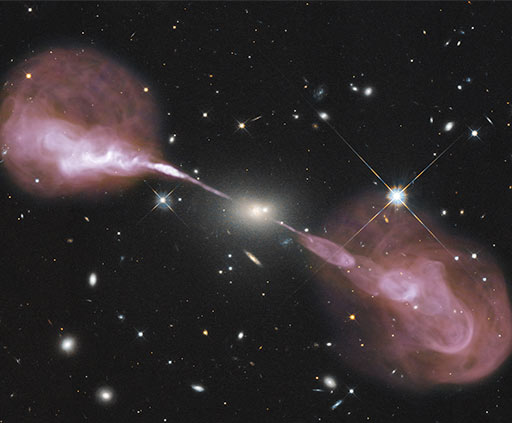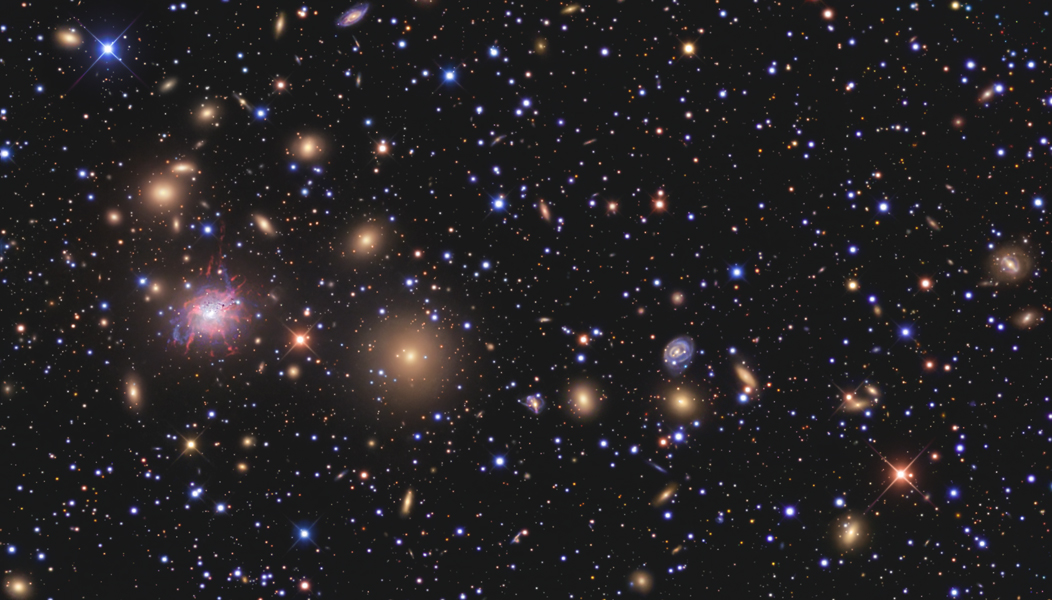https://en.wikipedia.org/wiki/NGC_4889 wrote:
<<
NGC 4889 (also known as Coma B) is an E4 supergiant elliptical galaxy. It was discovered in 1785 by the British astronomer Frederick William Herschel I, who catalogued it as a bright, nebulous patch. The brightest galaxy within the northern Coma Cluster, it is located at a distance of 94 million parsecs (308 million light years) from Earth.
As the largest and the most massive galaxy easily visible to Earth, NGC 4889 has played an important role in both amateur and professional astronomy, and has become a prototype in studying the dynamical evolution of other supergiant elliptical galaxies in the more distant universe.Unlike a flattened, disc-shaped spiral galaxy like the Milky Way, NGC 4889 has no visible dust lanes or spiral arms and has a smooth, featureless, egg-shaped profile that diminishes in luminosity with distance from the center. At the core of the galaxy is a supermassive black hole that heats the intracluster medium through the action of friction from infalling gases and dust. The gamma ray bursts from the galaxy extend out to several million light years of the cluster.
As with other similar elliptical galaxies, only a fraction of the mass of NGC 4889 is in the form of stars. They have a flattened, unequal distribution that bulges within its edge. Between the stars is a dense interstellar medium full of heavy elements emitted by evolved stars. The diffuse stellar halo extends out to one million light years in diameter. Orbiting the galaxy is a very large population of globular clusters. NGC 4889 is also a strong source of soft X-ray, ultraviolet, and radio frequency radiation.
NGC 4889 was not included by the astronomer Charles Messier in his famous Messier catalogue despite being an intrinsically bright object quite close to some Messier objects. The first known observation of NGC 4889 was that of Frederick William Herschel I, assisted by his sister, Caroline Lucretia Herschel, in 1785, who included it in the Catalogue of Nebulae and Clusters of Stars published a year later. In 1864, Herschel's son, John Frederick William Herschel, published the General Catalogue of Nebulae and Clusters of Stars. He included the objects catalogued by his father, including the one later to be called NGC 4889, plus others he found that were somehow missed by his father.
NGC 4889 is probably the largest and the most massive galaxy out to the radius of 100 Mpc (326 million light years) of the Milky Way. The galaxy has an effective radius which extends at 2.9 arcminutes of the sky, translating it to the diameter of 239,000 light years, about the size of the Andromeda Galaxy. In addition it has an immense diffuse light halo extending to 17.8 arcminutes, roughly half the angular diameter of the Sun, translating to 1.3 million light years in diameter.
As for its large size, NGC 4889 may also be extremely massive. If we took Milky Way as the standard of mass, it may be close to 8 trillion solar masses. However, as NGC 4889 is a spheroid, and not a flat spiral, it has a three-dimensional profile, so it may be as high as 15 trillion solar masses. However, as for elliptical galaxies, only a small fraction of the mass of NGC 4889 is in the form of stars that radiate energy. Assuming a mass to light ratio of 6.5 as with other elliptical galaxies, NGC 4889 may be a thousand times more massive than the Milky Way.
On December 5, 2011, astronomers measured the velocity dispersion of the central regions of two massive galaxies, NGC 4889, and the other being NGC 3842 in the Leo Cluster. According to the data of the study, they found out the central black hole of NGC 4889 is 5,200 times more massive than the central black hole of the Milky Way, or equivalent to 21 billion solar masses (best fit of data; possible range is from 6 billion to 37 billion solar masses). This makes it one of the most massive black holes on record. The diameter of the black hole's immense event horizon is about 20 to 124 billion kilometers, 2 to 12 times the diameter of Pluto's orbit. The ionized medium detected around the black hole suggests that NGC 4889 may have been a quasar in the past. It is quiescent, presumably because it has already absorbed all readily available matter.
Giant elliptical galaxies like NGC 4889 are believed to be the result of multiple mergers of smaller galaxies. There is now little dust remaining to form the diffuse nebulae where new stars are created, so the stellar population is dominated by old, population II stars that contain relatively low abundances of elements other than hydrogen and helium. The egg-like shape of this galaxy is maintained by random orbital motions of its member stars, in contrast to the more orderly rotational motions found in a spiral galaxy such as the Milky Way.
The space between the stars in the galaxy is filled with a diffuse interstellar medium of gas, which has been filled by the elements ejected from stars as they passed beyond the end of their main sequence lifetime. Carbon and nitrogen are being continuously supplied by intermediate mass stars as they pass through the asymptotic giant branch. The heavier elements from oxygen to iron are primarily produced by supernova explosions within the galaxy. The interstellar medium is continuously heated by the emission of in-falling gases towards its central SMBH.>>
 The Coma Cluster of Galaxies
The Coma Cluster of Galaxies



